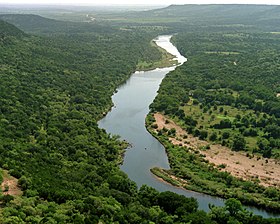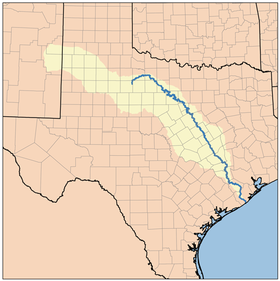| Brazos River Río de los Brazos de Dios | |
|---|---|
 Brazos River downstream of Possum Kingdom Lake, Palo Pinto County, Texas | |
 Brazos River watershed | |
| Location | |
| Country | United States |
| State | Texas |
| Physical characteristics | |
| Source | Llano Estacado |
| Source confluence | Stonewall County, Texas |
| • coordinates | 33°16′07″N 100°0′37″W / 33.26861°N 100.01028°W[1] |
| • elevation | 453 m (1,486 ft) |
| Mouth | Gulf of Mexico |
• location | Brazosport, Brazoria County, Texas |
• coordinates | 28°52′33″N 95°22′42″W / 28.87583°N 95.37833°W[1] |
• elevation | 0 m (0 ft) |
| Length | 1,352 km (840 mi) |
| Basin size | 116,000 km2 (45,000 sq mi) |
| Discharge | |
| • location | Freeport, Texas |
| • average | 237.5 m3/s (8,390 cu ft/s) |
| • minimum | 0.76 m3/s (27 cu ft/s) |
| • maximum | 2,390 m3/s (84,000 cu ft/s) |
The Brazos River (/ˈbræzəs/ BRAZ-əs, Spanish: [ˈbɾasos]), called the Río de los Brazos de Dios (translated as "The River of the Arms of God") by early Spanish explorers, is the 14th-longest river in the United States at 1,280 miles (2,060 km) from its headwater source at the head of Blackwater Draw, Roosevelt County, New Mexico[2] to its mouth at the Gulf of Mexico with a 45,000-square-mile (116,000 km2) drainage basin.[3] Being one of the largest rivers in Texas,[4] it is sometimes used to mark the boundary between East Texas and West Texas.
The river is closely associated with Texas history, particularly the Austin settlement and Texas Revolution eras. Today major Texas institutions such as Texas Tech University, Baylor University, and Texas A&M University are located close to the river's basin, as are parts of metropolitan Houston.
- ^ a b "Brazos River". Geographic Names Information System. United States Geological Survey, United States Department of the Interior.
- ^ Kammerer, J.C. (1987). "Largest Rivers in the United States". United States Geological Survey. Retrieved 2006-07-15.
- ^ Hendrickson Kenneth E. Jr. (1999-02-15). "Brazos River". The Handbook of Texas Online. The General Libraries at the University of Texas at Austin and the Texas State Historical Association. Archived from the original on July 10, 2011. Retrieved 2006-07-22.
- ^ "Brazos River." Britannica Academic, Encyclopædia Britannica, 11 Aug. 2018. academic.eb.com/levels/collegiate/article/Brazos-River/16291. Accessed 27 Nov. 2018.